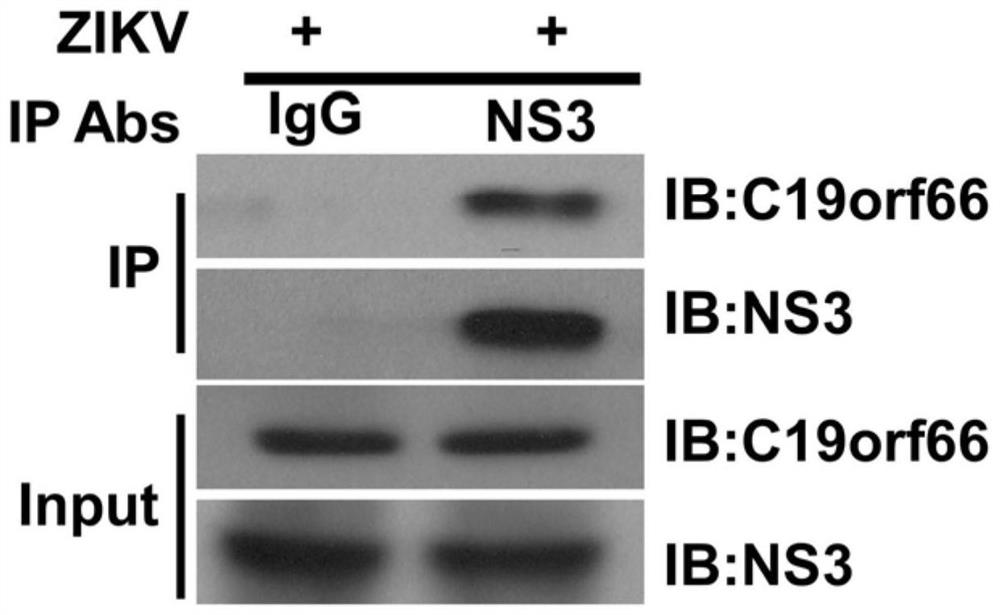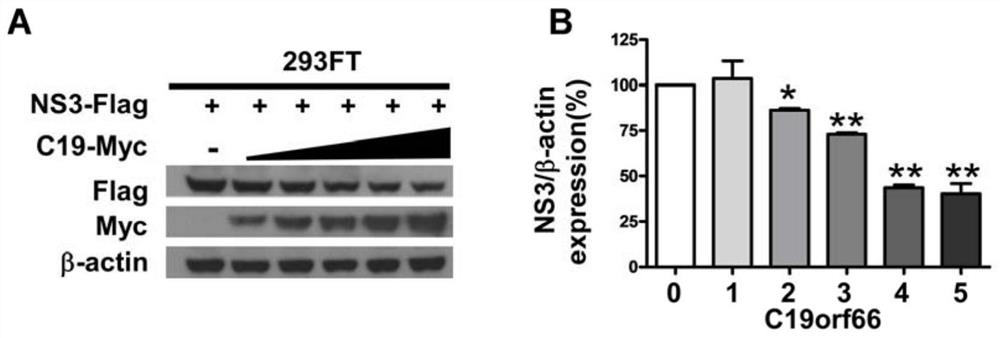Application of antiviral protein c19orf66 in antiviral drugs targeting Zika virus nonstructural protein ns3
A non-structural protein, Zika virus technology, applied in antiviral agents, peptide/protein components, resistance to vector-borne diseases, etc., can solve the problem of unknown precise drug target of C19orf66
- Summary
- Abstract
- Description
- Claims
- Application Information
AI Technical Summary
Problems solved by technology
Method used
Image
Examples
Embodiment 1
[0022] Example 1 Cellular colocalization of C19orf66 and Zika virus nonstructural protein NS3.
[0023] 1. Experimental method
[0024] 1. Cell transfection.
[0025] (1) Using hNPC as a cell model, 24 hours before transfection, inoculate an appropriate amount of cells on a circular cover slip treated with ultraviolet sterilization;
[0026] (2) Add 200 ng each of the plasmid pCEDF-C19orf66-myc with high expression of C19orf66 and the plasmid pCDEF-NS3-flag with high expression of NS3 into 25 μl Opti-MEM, add 1 μl of P3000TM, and mix gently;
[0027] (3) Add 2 μl LipofectamineTM 3000 reagent to 25 μl Opti-MEM, mix gently, and place at room temperature for 5 minutes;
[0028] (4) Mix the above (2) and (3) liquids, flick the tube wall to mix, and let stand at room temperature for 5 minutes;
[0029] (5) adding (4) into the culture medium of hNPC cells, and culturing in a 37°C incubator;
[0030] (6) Change the medium after 4 to 6 hours and continue culturing.
[0031] 2. Ce...
Embodiment 2
[0048] Example 2 Interaction between C19orf66 and Zika virus non-structural protein NS3.
[0049] 1. Experimental method
[0050] 1. Spread an appropriate amount of cells into a cell culture dish P100. After 24 hours, infect Zika virus (1 MOI). After 48 hours, the cells are used for co-immunoprecipitation, and the corresponding proteins are detected by Western blotting.
[0051] 2. The method of co-immunoprecipitation is as follows:
[0052] (1) Take out the treated cells, discard the original medium, and wash twice with pre-cooled 1×PBS;
[0053] (2) Add pre-cooled 6ml 1×PBS, scrape the cells from the culture dish, transfer the cell solution to a 15ml centrifuge tube, and centrifuge at 2000rpm 4°C for 5min;
[0054] (3) Discard the supernatant, add 500μl 1×IP lysis buffer (containing protease inhibitors) to the cell pellet, transfer the cell suspension to a 1.5ml centrifuge tube, place it on ice, shake it every 10min, Each time for 30s, maintain for 30min to ensure that th...
Embodiment 3
[0062] Example 3 Effect of C19orf66 on the content of Zika virus non-structural protein NS3 in cells.
[0063] 1. Experimental method
[0064] 1. The method of exogenous high expression is as described in Step 1 of Example 1. The amounts of the C19orf66 plasmid were 0, 0.2, 0.4, 0.6, 0.8, and 1 ug, respectively, the amount of the plasmid NS3-Flag was 2 ug, and the amounts of P3000TM and LipofectamineTM were changed accordingly.
[0065] 2. After 48 hours of transfection, the protein was collected, and the corresponding protein was detected by immunoblotting.
[0066] 3. The immunoblotting steps are the same as those in Example 2.
[0067] see results image 3 As shown, when the expression level of C19orf66 in cells increases, the content gradient of NS3 decreases, showing that C19orf66 promotes the degradation of Zika virus non-structural protein NS3.
PUM
 Login to View More
Login to View More Abstract
Description
Claims
Application Information
 Login to View More
Login to View More - R&D
- Intellectual Property
- Life Sciences
- Materials
- Tech Scout
- Unparalleled Data Quality
- Higher Quality Content
- 60% Fewer Hallucinations
Browse by: Latest US Patents, China's latest patents, Technical Efficacy Thesaurus, Application Domain, Technology Topic, Popular Technical Reports.
© 2025 PatSnap. All rights reserved.Legal|Privacy policy|Modern Slavery Act Transparency Statement|Sitemap|About US| Contact US: help@patsnap.com



